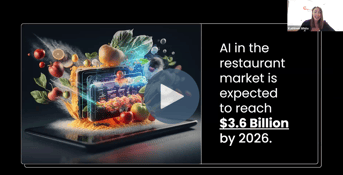Like countless other operators, Cynthia Wong found herself quickly pivoting amid the pandemic. Owner of Life Raft Treats, a Charleston-based truck known for its novelty ice cream crafted into creative shapes, Wong took a strategy that now echoes loud across the industry: “Diversify your revenue streams.”
In October 2020, Wong turned to popular food delivery website Goldbelly. The e-commerce platform works with 1,000-plus restaurants across 50 states. And it’s here that Wong now sells items like her popular “Not Fried Chicken” ice cream buckets to a customer base of millions.
“It’s probably close to about 60% of our business now,” says Wong. “We can reach everyone in the United States, which is great, and we’ve been able to pick up distributors who saw we were doing well on it.”
Not just a pandemic lifeline, Goldbelly played a fundamental role in Life Raft Treat’s overall growth, shifting the business out of a tiny commissary kitchen into a 6,000-square-foot facility.
Yet, given the competition on the platform, not everyone is as successful, and even Wong admits she’s had a few items flop. We asked Wong to share her top learnings after being on Goldbelly for more than a year and a half. Below, find Wong’s top tips for reigning in customers and driving success.
The more niche the product, the better you’re going to do.
It’s hard to compete with the thousand-plus purveyors on Goldbelly when selling everyday items like cakes and cookies, unless you already have established name recognition for those items.
“Either it has to be something that’s extremely unique, or you’re a known restaurant with a lot of tourists,” says Wong. “If you’re famous for your lobster rolls, and people want to go back home and get them for a special occasion or give them to friends, then you’ve got something.”
Consider which of your items are most giftable.
As Wong points out, Goldbelly is frequently tapped by those looking to gift loved ones with their favorite foods or one-of-a-kind treats. It could be a novelty item, like Life Raft Treats’ donut-shaped ice cream cake, or a popular hometown dish, like a famous Philly cheesesteak or Chicago deep dish.
If you’re not among those making iconic items, consider what creative, attention-getting strategies you can use to give current menu specialties more gift appeal.
Hire a professional product photographer.
“What looks cute and fun on your Instagram doesn’t look good on GoldBelly,” says Wong, noting
it’s “extremely important” to have all retail items captured by a professional.
Look for a photographer who understands product photography versus a food photographer who focuses on lifestyle shots, says Wong. And consider finding one who’s comfortable working with external lighting to create the kinds of bright, punchy, colorful product shots that are quick to draw eyes.
“Our photographer’s been an integral part of our business,” says Wong.
Make sure you have the space and staff to scale.
Packaging of products takes space – and lots of it.
“There’s never enough space in a restaurant – for prep, for refrigeration, for storage,” says Wong. “If you have a product that’s really unique, consider a fulfillment service, which trims your margins down even more, but I can’t imagine having the capacity to do it in-house.”
Once you have the space lined up, make sure you have the staff to operate within it. If your products prove successful, you’ll likely need to designate at least one person to your retail operation.
“We had to eventually hire two, full-time people just to package, and we’re about to get a third, and my husband now handles all the distribution,” says Wong.
Strategically set pricing to walk the line between too expensive and too ordinary.
Product pricing obviously needs to be higher than if selling out of your own restaurant. But exactly where to set prices can prove tricky.
“A lot of it is just covering your costs, which are painfully high right now. And then there’s gut-check pricing – pricing something where it feels like an exclusive, special item but not so high that people are turned off,” says Wong. “What’s that threshold where there seems like there’s value even though it’s expensive?”
To start, look to Goldbelly sales representatives for pricing suggestions based on the market. Wong’s found the $99 range works well for Life Raft Treats products. “Most people understand it’s overnight shipping, and the fact that you can wake up tomorrow and get ice cream still in perfect condition does cost a lot of money,” says Wong.
Allow two to three months to assess whether to pull products.
Within a couple months, you can typically determine if a product’s driving enough orders to be worth your time, says Wong.
“A lot of the decisions we make are based on shipping options because not everything fits in the same box, and we’re not going to order a couple more pallets of boxes if a product’s not working out,” Wong notes. “Another good tell is if there’s a holiday and that product still doesn’t pick up.”
Develop good relationships with your sales and marketing reps.
“A lot of the GoldBelly marketing is based on how enthusiastic the team is on the product, and in any market, building those relationships with the people who are doing the talking for your product is important,” says Wang.
When launching a new product, send samples to your Goldbelly reps in advance so they can be among the first to try it.
Regularly market your presence on Goldbelly to existing customers.
Your best restaurant customers are likely to be some of your best Goldbelly purchasers, sending your products to people they love. Post a clearly visible link to your GoldBelly page on your website and ideally on your social media platforms, too. Then spread the word through regular social media posts.
“Anything you want to say, you have to repeat over and over again on those platforms,” says Wong.
Go all in, or don’t go at all.
Simply want to dip your toes into retail? There are better options than Goldbelly.
“Thinking that it'd be nice to ship 10 packages a week isn’t going to work. You need to do it at such a volume that it becomes a big pillar of your business because it’s a lot of work,” says Wong. “There’s the labeling, and we ship in roto-molded coolers with cardboard boxes on the outside, and it all gets extremely expensive – if you don’t do these things in bulk, it doesn’t make sense.”
Grace Dickinson is a reporter at Back of House. Send tips or inquiries to grace@backofhouse.io.





